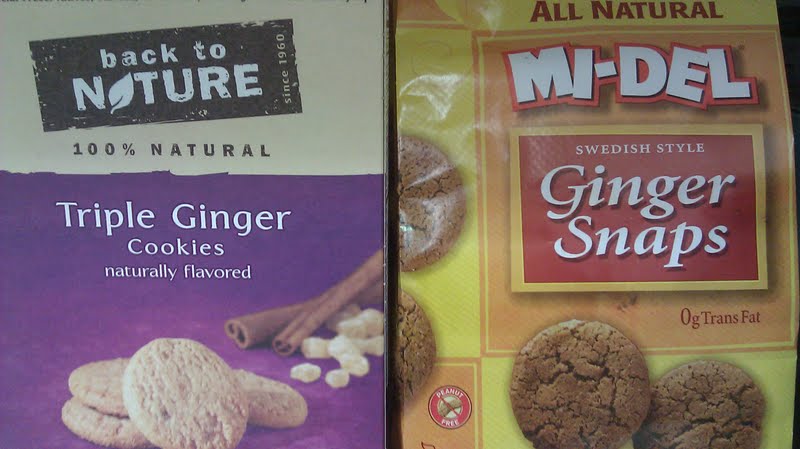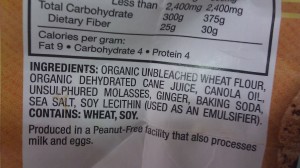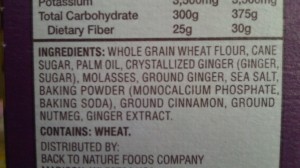Table of Contents[Hide][Show]

Does the snack aisle at your local healthfood store sometimes paralyze you? Do you look at the ingredients labels trying to decide exactly which cookies are the best ones to buy and yet feel overwhelmed by the numerous choices available all beckoning with the labels “all natural” or “organic”?
If so, you are not alone. This happens to me all the time.
Granted, I try my best to avoid the snack aisle at the healthfood store as much as possible and I don’t even go down the snack aisle at the supermarket because there are zero offerings there of any value. As much as is humanly possible, I prefer to make my own snacks for my family as this is always the most nutritious not to mention budget conscious way to go.
But let’s face it. Life happens and sometimes things just don’t go as scheduled.
All sorts of things from flat tires to your child’s badly scraped knee can occur to mess up your plans for baking an afternoon batch of cookies for school lunches the next day.
What to do then?
I thought it might be fun to analyze two different brands of cookies that I might consider buying when I am in search of a decent after lunch treat for my kids and far behind in my cookie baking duties.
Ginger snaps are one of my favorite store cookies as they are typically lower in sugar per serving than most other types of processed cookies. They also taste similar to the grain free ginger snaps I make myself, so buying a boxed version made with wheat flour on occasion is not going to all of a sudden cause my children to prefer the processed cookies over my own.
The picture at the top of this post is of the two brands of ginger snaps available at my local healthfood store.
Let’s analyze the ingredients labels of each and see if one of them is the clear winner over the other.
The Front of the Cookie Packages
From the front of the packages, you can’t really discern much if any difference. They both say “all natural” or “naturally flavored”.
The Mi-del brand says “Swedish Style” which I admit would draw me in as I like anything that suggests that the cookies are based on some traditional recipe. Of course, this may or may not be true. It’s all just marketing on the front of the package after all!
From a visual standpoint, the colors of the Back to Nature brand are far more appealing than the Mi-Del brand which are a bit harsh on the eye. Then again, purple is my favorite color so maybe that’s just my personal preference.
Ingredients Label Comparison
With the front of the packages not really telling us much, it is necessary to examine the ingredients labels to get the full story.

The first ingredient label to the right is of the Mi-Del Ginger Snaps.
I like that the wheat used is organic. That is a definite plus. In addition, the sweetener is organic dehydrated cane juice which is acceptable.
I don’t like that canola oil is used for the shortening as this is very potentially GM canola as it is not organic. In addition, canola oil is a polyunsaturated vegetable oil which almost certainly means that it is rancid.
Canola contains high amounts of omega 3 fats which are very delicate and can never be heated. You most certainly cannot bake cookies with it!. Use of canola in a boxed snackfood virtually ensures a rancid, health robbing product even if the ingredients are all organic.
Another item I don’t like is the use of soy lecithin. It is not organic soy lecithin, so the odds are good that it is GM soy given that over 90% of the soy in the the United States is genetically modified at present.
The second ingredient label to the right is of the Back to Nature Triple Ginger Cookies.

You’ll notice right away that the wheat flour used is not organic. The sweetener is also not as good quality because it is listed simply as cane sugar. It is not organic and it is not clear whether it is from dehydrated cane juice. It could easily be plain white sugar and probably is.
Not good.
So far, the Mi-Del Ginger Snaps are way in the lead.
However, the next ingredient changes the game entirely as palm oil is listed as the shortening.
This is very good as palm oil is a much healthier choice that the rancid canola oil used in the Mi-Del Ginger Snaps. Palm oil is acceptable for use in cookies and crackers. While coconut oil or butter would be best, palm oil can most definitely be considered a healthy fat.
Continuing down the ingredients label, all the other ingredients are excellent as well with no ominous “soy lecithin” listed.
Which Brand Did I Choose?
After analyzing the ingredients labels for these two boxes of ginger cookies, which brand did I ultimately choose?
If you guessed the Back to Nature Triple Ginger Cookies, you are correct!
The fact that the Mi-Del cookies are made with organic wheat flour and organic evaporated cane juice is insignificant compared with the fact that the Back To nature cookies use the much higher quality palm oil and no soy lecithin.
If you ever find yourself torn between two different brands of snack foods, always choose the one with the healthy fat like palm oil. The fat that is used is much more important than whether the flour or sugar used is organic.
In addition, go for the brand that clearly has no GMOs in it and that would be the Back to Nature brand as well.
Do all Back to Nature cookies get the thumbs up? Not necessarily.
I haven’t checked the labels on all the different cookies offered by this company, so don’t go and buy them without checking closely for yourself.
For that occasional need for a decent box of cookies from the store, though, the Triple Ginger Cookies pass with flying colors.
Sarah, The Healthy Home Economist








Since when is Palm Oil healthy, Several studies have linked palm oil to cardiovascular diseases, other than that because of the palm oil industry many forests in Asia and Africa have been destroyed and is causing the extinction of many species such as elephants, tigers and rhinos.
If palm oil is not artificially hydrogenated and is produced in an environmentally sustainable fashion, it is healthy and green. Naturally saturated fats definitely have a place in a healthful diet. But you do have to read the fine print and source it carefully.
Is it correct that back to nature does not use GMO products? My husband recently bought these cookies and we were excited to find a healthy cookie that actually tastes good! Then he came across an article tonight that warned that back to nature believes that GMOs are not bad for you and uses them regularly…?
Very informative!
Thank you Sarah! I really enjoyed this post. Although I’m a lot healthier–inside and out–because of my conscious decision to eat healthier and more traditional foods, there’s a part of myself that seems to get paranoid every once and a while: “I can’t eat at that restaurant!” or “I wonder if those granola bars will cause a reaction?” I feel it’s so important to emphasize that we all have to do the best we can in the moment, and your tips on which brand of cookie to choose are awesome. I think it’s a great idea to choose a type of food you already make at home and that your family is familiar with. That way, they won’t see them as an unhealthy treat and feel deprived when you’re not buying them. Again Sarah, great info and looking forward to incorporating these tips and tricks with my family.
While I totally agree with you for the most part, and I too read labels like crazy, I have to admit I freak out a bit when I see Palm oil being used. This is why…
About 88 percent of global palm oil production was in Malaysia and Indonesia in 2007. Although much of this production took place on land long ago established for agriculture, some of it occurred in areas that were newly cleared specifically for oil palm cultivation.
The most threatened ecosystems by expansion of oil palm plantations are rainforests and peatlands. Peatlands are swampy areas where the soils are made of peat – decomposed vegetation. Peat acts as a sponge, soaking up water and helping prevent floods. It also stores large amounts of carbon.
When peatlands are drained, the stored carbon reacts with air to release carbon dioxide into the atmosphere, increasing concentrations of the greenhouse gas. The dry peat then becomes highly flammable, increasing the risk of large-scale fires when plantation developers use fire to clear land and burn agricultural waste.
Greenhouse gas emissions also result when rainforest is cleared for oil palm plantations. Worse, oil palm plantations support very low levels of biodiversity, meaning most of the plants and animals once found in the rainforest must either move or perish. Oil palm plantations are not good for wildlife and endangered species like the orangutan, the Sumatran rhino, the pygmy elephant of Borneo, and the Sumatran tiger are all threatened by development for oil palm.
What are your thoughts? Thanks 🙂
Sarah, I think you should do a post on healthy real food options for kids lunches. I am a single mom and we qualify for free lunch at school so my children get the garbage that’s served for free. I try really hard to make every extra effort at home like raw milk, little sugar, keifer, farm eggs, stocks, sourdough, lacto ferments etc. When it comes to sending something with them for snack or lunch at school I feel so limited. I’d love some great ideas.
I like the California Almonds from Back to Nature as a compromise as well. They are soaked in sea salt before roasting, with no added oils. Of course they are going to be irradiated and lose a lot of good stuff in the roasting process, but they are inexpensive, and sometimes sourcing good raw almonds, soaking and toasting them myself is just too daunting.
Yes, I would have avoided the cookies with canola oil and soy lecithin because there is more than a 90% likelihood that they are genetically modified/engineered. More than 75 to 95% of corn, soy, cottonseed, sugar beets and canola are GMOs. Right now, LabelGMOs.org is gathering signatures to get the Initiative CALIFORNIA RIGHT TO KNOW GENETICALLY ENGINEERED FOOD ACT on Nov ballot. Whether you believe GMOs are good or bad to eat, we have a right to know what is in our food. By labeling GMOs we could be better consumers. To learn more about GMOs google Jeffrey Smith of Responsible Technology, Organic Consumer Association or watch the free documentary The Future of Food on youtube.
Also…..can you do more articles on GMO’s – explaining what they are, where you can get them, why they are in our food, etc. etc…..
Sarah – thank you for doing these comparisons – it is much needed – please keep doing this with products so we finally get the “bottom line” on products we just have to buy once in a while. I sure wish there was a company out there that we could depend on for really good ingredients but guess that’s a pipe dream.